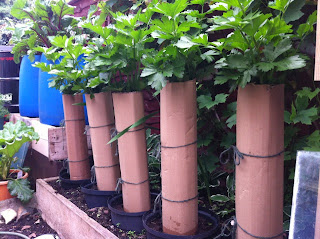As with any giant vegetable, it is essential to select the correct giant seed variety. Varieties such as Mammoth white celery are very successful.
Celery likes to grow in a compost rich, moisture retentive soil. Choose a plot that is partially shaded, receiving around 6 hours of sunshine a day. Dig over your celery bed on a dry day in late autumn or early winter. Make trenches 50 cm deep, breaking up the bottom of the trench with a fork. Incorporate a barrow of well rotted farm yard manure or compost., 70 g bone meal and 80 g sulphate of potash for every 4 square metres of soil. In April add a general fertiliser such as calcified seaweed into the soil surface and work well.
Celery likes to grow in a compost rich, moisture retentive soil. Choose a plot that is partially shaded, receiving around 6 hours of sunshine a day. Dig over your celery bed on a dry day in late autumn or early winter. Make trenches 50 cm deep, breaking up the bottom of the trench with a fork. Incorporate a barrow of well rotted farm yard manure or compost., 70 g bone meal and 80 g sulphate of potash for every 4 square metres of soil. In April add a general fertiliser such as calcified seaweed into the soil surface and work well.
Celery has a long growing season so you will need to start sowing your seeds indoors in mid February, around 8-10 weeks before your last expected frosts. Fill 9 cm pots with John Innes 'seed and potting' compost. Sprinkle the celery seeds over the top of the compost and cover very lightly with a layer of soil. You may find it easier to distribute the small seeds if you mix them with some horticultural sand.
Place the pots in a pan of water and leave to soak until the compost is damp. Cover the pots with cling film, glass or propagator lid and place in a warm, bright position that is not in direct sunlight. Remove the covers when the seeds have germinated, usually 12-18 days, and water as required.
Prick out or thin the seedlings when they are large enough to transplant and place into individual pots. When soil temperatures reach 50 F and above your celery is ready to be planted outside. Plant your seedlings when they have 5 or 6 leaves showing, ensuring that you harden off your seedlings for several weeks prior to planting into your bed. Plant at 30 cm spacing's.
Celery is a thirsty and hungry crop that does not tolerate drought of any kind. Water regularly to keep the soil moist and feed the plants with a liquid fertiliser on a regularly basis during the summer months. Remove any competing weeds carefully to avoid damage to the plants.
You may wish to blanch your celery, artificially turning the green part of the plant white and elongating the stems. This can help to make the celery more tender and presentable at garden shows. This can be done either by removing any side shoots and covering the lower half of the celery with newspaper or cardboard several weeks before you harvest or by slowly mounding up soil around the growing plant during the growing season.
Your giant celery will be ready to harvest from September onwards.




you can now buy Celery Seeds HYBRID – ( 100-120 Seeds)
ReplyDeleteonline from Gardener Shopping